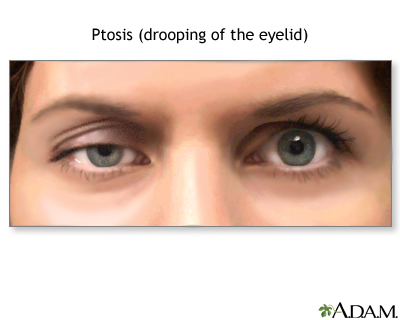Ptosis - infants and children
Blepharoptosis - children; Congenital ptosis; Eyelid drooping - children; Eyelid drooping - amblyopia; Eyelid drooping - astigmatism
Ptosis (eyelid drooping) in infants and children is when the upper eyelid is lower than it should be. This may occur in one or both eyes. Eyelid drooping that occurs at birth or within the first year is called congenital ptosis.
Images

I Would Like to Learn About:
Considerations
Ptosis in infants and children is often due to a problem with the muscle that raises the eyelid. A nerve problem in the eyelid can also cause it to droop.
Ptosis may also occur due to other conditions. Some of these include:
- Trauma at birth (such as from the use of forceps)
- Eye movement disorders
- Brain and nervous system problems
- Eyelid tumors or growths
Eyelid drooping that occurs later in childhood or adulthood may have other causes.
SYMPTOMS
Children with ptosis may tip their head back to see. They may raise their eyebrows to try to move the eyelid up. You may notice:
- Drooping of one or both eyelids
- Increased tearing
- Blocked vision (from severe eyelid drooping)
EXAMS AND TESTS
The health care provider will do a physical exam to determine the cause.
The provider also may do certain tests:
- Slit-lamp examination
- Ocular motility (eye movement) test
- Visual field testing
Other tests may be done to check for diseases or illnesses that may be causing ptosis.
TREATMENT
Eyelid lift surgery can repair drooping upper eyelids.
- If vision is not affected, surgery can wait until age 3 to 4 when the child has grown a little bigger.
- In severe cases, surgery is needed right away to prevent "lazy eye" (amblyopia).
The provider will also treat any eye problems from ptosis. Your child may need to:
- Wear an eye patch to strengthen vision in the weaker eye.
- Wear special glasses to correct an uneven curve of the cornea that causes blurred vision (astigmatism).
Children with mild ptosis should have regular eye exams to make sure amblyopia does not develop.
Surgery often works well to improve the look and function of the eye. Some children need more than one surgery.
When to Contact a Medical Professional
Contact your provider if:
- You notice your child has a drooping eyelid
- One eyelid suddenly droops or closes
Related Information
Eyelid droopingReferences
Bass N. Hypotonia and neuromuscular disease in the neonate. In: Martin RJ, Fanaroff AA, Walsh MC, eds. Fanaroff and Martin's Neonatal-Perinatal Medicine. 11th ed. Philadelphia, PA: Elsevier; 2020:chap 56.
Olitsky SE, Marsh JD. Abnormalities of the lids. In: Kliegman RM, St. Geme JW, Blum NJ, Shah SS, Tasker RC, Wilson KM, eds. Nelson Textbook of Pediatrics. 21st ed. Philadelphia, PA: Elsevier; 2020:chap 642.
Pavone P, Cho SY, Praticò AD, Falsaperla R, Ruggieri M, Jin DK. Ptosis in childhood: A clinical sign of several disorders: Case series reports and literature review. Medicine (Baltimore). 2018;97(36):e12124. PMID: 30200099 pubmed.ncbi.nlm.nih.gov/30200099/.
BACK TO TOPReview Date: 2/12/2023
Reviewed By: Franklin W. Lusby, MD, Ophthalmologist, Lusby Vision Institute, La Jolla, CA. Also reviewed by David C. Dugdale, MD, Medical Director, Brenda Conaway, Editorial Director, and the A.D.A.M. Editorial team.

Health Content Provider
06/01/2025
|
A.D.A.M., Inc. is accredited by URAC, for Health Content Provider (www.urac.org). URAC's accreditation program is an independent audit to verify that A.D.A.M. follows rigorous standards of quality and accountability. A.D.A.M. is among the first to achieve this important distinction for online health information and services. Learn more about A.D.A.M.'s editorial policy, editorial process and privacy policy. A.D.A.M. is also a founding member of Hi-Ethics. This site complied with the HONcode standard for trustworthy health information from 1995 to 2022, after which HON (Health On the Net, a not-for-profit organization that promoted transparent and reliable health information online) was discontinued. |
The information provided herein should not be used during any medical emergency or for the diagnosis or treatment of any medical condition. A licensed medical professional should be consulted for diagnosis and treatment of any and all medical conditions. Links to other sites are provided for information only -- they do not constitute endorsements of those other sites. © 1997- 2025 A.D.A.M., a business unit of Ebix, Inc. Any duplication or distribution of the information contained herein is strictly prohibited.
